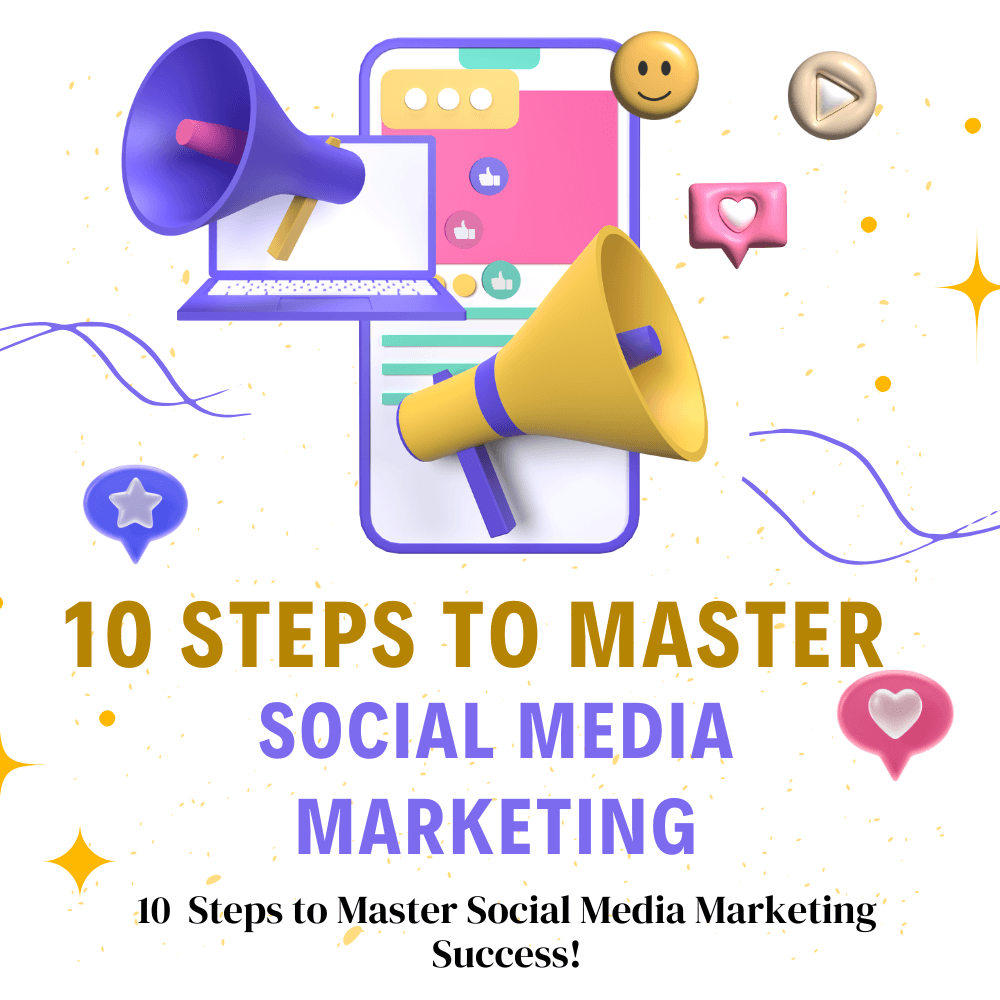10 Steps to Mastering Social Media Marketing for Your Brand
Introduction
In today’s fast-paced digital landscape, social media marketing has evolved into an essential tool for brands looking to connect with their audience. With over 4.7 billion active social media users worldwide, businesses have the unprecedented opportunity to engage potential customers on platforms like Facebook, Instagram, Twitter, and LinkedIn. The large number of users means brands can engage with many potential customers. However, creating a successful social media strategy requires more than just setting up an account and posting sporadically. By creating a strong social media strategy, businesses can connect with their audience and achieve their goals.
Step 1: Define Your Goals
The journey to successful social media marketing begins with defining clear, actionable goals. What are the main goals you want to reach with your social media efforts? Whether it’s increasing brand awareness, generating leads, boosting sales, or enhancing customer loyalty, having specific objectives will guide your strategy and keep you focused.
Why Goal-Setting Matters
Setting goals not only gives you a roadmap for your social media activities but also allows you to measure success effectively. Without defined goals, it becomes challenging to determine the impact of your efforts and make necessary adjustments.

Setting SMART Goals
To create effective social media goals, consider using the SMART criteria:
- Specific: Clearly articulate what you want to achieve. Instead of a vague goal like “get more followers,” aim for “gain 500 new followers on Instagram in the next three months.”
- Measurable: Establish metrics to track progress. This could include follower count, engagement rates, or conversion numbers.
- Achievable: Aim for realistic goals that are practical and grounded in your available resources and past performance. It’s better to start small and gradually scale up than to set unattainable targets.
- Relevant: Set goals that connect directly to your larger business aims. For example, if your business is focused on e-commerce, your social media goals should revolve around driving traffic to your website and increasing sales.
- Time-Bound: Create target dates for your goals to boost urgency and and to maintain accountability.
By clearly defining your goals, you’ll be able to craft a more focused social media strategy that aligns with your business objectives.
Step 2: Know Your Audience
Understanding your audience is critical to developing an effective social media strategy. Who are they? What do they care about? Which platforms do they frequent? Conducting thorough audience research will provide you with insights to create content that resonates with your target demographic.
Creating Audience Personas
One effective way to gain a deeper understanding of your audience is by creating detailed audience personas. These fictional characters represent your ideal customers and can include information such as:
- Demographics: Age, gender, location, and income level.
- Interests: Hobbies, passions, and values that influence their buying decisions.
- Pain Points: Challenges or problems they face that your product or service can solve.
- Online Behavior: Which social media platforms they use and how they engage with content.
Conducting Surveys and Research
Utilize surveys, interviews, and social media analytics to gather data about your audience. Tools like Google Analytics, Facebook Insights, and Instagram Insights can provide valuable information about user demographics and engagement patterns.
Tailoring Your Content
Once you have a clear understanding of your audience, make your content to meet their needs and preferences. Consider creating a mix of educational, entertaining, and promotional posts that speak directly to your audience’s interests and pain points.
Step 3: Choose the Right Platforms
Not all social media platforms are created equal. Each platform has its own specific audience, advantages, and limitations. Understanding where your audience spends their time and what type of content works best on each platform is essential for effective social media marketing.

Assessing Platform Demographics
Here’s a quick overview of some popular platforms and their demographics:
- Facebook: Ideal for reaching a wide audience, particularly older adults. Great for community building and sharing a variety of content types.
- Instagram: Perfect for brands with eye-catching visuals, this platform emphasizes strong imagery. Popular among younger demographics, making it suitable for lifestyle, fashion, and food brands.
- Twitter: Great for real-time engagement and news updates. Appeals to a diverse audience, but is particularly popular among professionals and younger users.
- LinkedIn: The go-to platform for B2B marketing. Ideal for professional services and networking, targeting professionals and decision-makers.
Choosing the right social media platform can significantly improve your campaign performance, maximizing your return on investment by reaching users where they are most active.
Focusing on 2-3 Platforms
Rather than spreading yourself too thin across numerous platforms, focus on 2-3 that align best with your brand and where your target audience is most active. This allows you to dedicate more time and resources to creating high-quality content and engaging with your community.
Adapting Content to Each Platform
Every platform has its specific attributes and user behaviors. Ensure your content is made to fit the nuances of each platform. For instance, use high-quality images and short captions on Instagram, while engaging in longer, more in-depth discussions on LinkedIn.
Step 4: Develop a Content Strategy
Content is the backbone of social media marketing. A well-crafted content strategy will ensure your posts are engaging, relevant, and aligned with your goals.
Crafting a Balanced Content Mix
Your content should consist of a variety of post types to keep your audience engaged. Aim for a mix of:
- Promotional Posts: Showcase your products or services, and highlight special offers or events.
- Educational Content: Share practical advice, how-to, and insights that benefit your followers.
- Entertaining Posts: Incorporate humor, memes, or relatable content that resonates with your audience.
- User-Generated Content: Encourage your followers to share their experiences with your brand, and showcase their content on your channels.
Planning with a Content Calendar
A content calendar is a powerful tool for organizing your social media posts and ensuring consistency. Outline what content you’ll post, when you’ll post it, and on which platforms. This helps you maintain a steady flow of content and allows you to align your posts with important dates or events.

Incorporating Seasonal and Trend-Based Content
Don’t forget to incorporate seasonal and trending content into your strategy. Stay updated on current events, holidays, and social media trends that are relevant to your brand.
This not only keeps your content fresh but also increases the chances of engagement as users relate to timely topics.
Step 5: Create Engaging Content
Now that you have a content strategy in place, it’s time to create content that captivates your audience.
Engaging content is not only visually appealing but also encourages interaction and fosters a connection with your brand.
Use High-Quality Visuals
Visual content is essential for capturing attention on social media. Use clear images, graphics, and videos that match your brand’s style. Platforms like Canva and Adobe Spark offer user-friendly tools to create eye-catching visuals.
Craft Compelling Captions
While visuals are essential, don’t underestimate the power of well-written captions. Use compelling language that encourages users to take action—whether that’s liking, sharing, or commenting on your post.
Consider asking questions, sharing anecdotes, or incorporating calls-to-action (CTAs) to boost engagement.
Tell a Story
Incorporating storytelling into your content can significantly enhance its appeal.
Share behind-the-scenes glimpses of your brand, customer success stories, or personal anecdotes that resonate with your audience. Authenticity is key—show your audience the human side of your brand.
Utilize Interactive Content
Encourage engagement by incorporating interactive elements into your posts.
Polls, quizzes, and contests are excellent ways to foster participation and get feedback from your audience.
This not only boosts engagement but also gives you important information about what your audience likes.
We explored the initial five steps to mastering social media marketing: defining your goals, understanding your audience, selecting the right platforms, developing a content strategy, and creating engaging content.
Each of these steps lays a strong foundation for building a successful social media presence for your brand.
The remaining five steps, including user-generated content, audience engagement, performance analysis, and more advanced tactics to help you refine your social media efforts.
Step 6: Leverage User-Generated Content
User-generated content (UGC) is a powerful tool for enhancing your brand’s credibility and fostering community engagement.
UGC refers to any content—images, videos, reviews, or testimonials—created by your customers and shared on social media.
Including user-generated content in your social media marketing can help you connect better with your audience and reach more people.
By showcasing this content, you not only highlight your customers’ experiences but also build trust with your audience.
Why UGC Matters
- Authenticity: People are more likely to trust what their peers create compared to traditional marketing ads. Featuring UGC can make your brand appear more relatable and trustworthy.
- Cost-Effective: Instead of investing heavily in professional photography or videography, you can utilize content created by your customers, saving time and resources.
- Engagement: Sharing UGC encourages your audience to participate and engage with your brand. It builds a feeling of community and makes your customers feel appreciated.
How to Encourage UGC
To encourage your customers to create content about your brand, consider the following strategies:
- Create Branded Hashtags: Develop a unique hashtag that customers can use when sharing their experiences. This makes it easy for you to find and share their content.
- Run Contests or Challenges: Host a contest that encourages users to share photos or videos using your product. Offer rewards like special discounts or giveaways to encourage people to take part.
- Feature Customers on Your Profile: Showcase customer stories or highlight their posts on your social media channels. This not only acknowledges their support but also inspires others to share their experiences.
Step 7: Engage With Your Audience
Engagement is at the heart of social media marketing.
Building meaningful relationships with your audience goes beyond posting content; it involves actively participating in conversations, responding to comments, and fostering a sense of community.
The Importance of Engagement
- Builds Relationships: Engaging with your audience helps create a sense of connection, fostering brand loyalty and trust.
- Increases Visibility: Social media algorithms often prioritize posts with high engagement, meaning your content is more likely to be seen by a broader audience.
- Valuable Feedback: Interaction with your audience allows you to gather feedback, understand their preferences, and refine your offerings accordingly.

Strategies for Effective Engagement
To enhance your engagement efforts, consider these tactics:
- Respond Promptly: Make it a priority to reply to comments and messages in a timely manner. A quick response shows that you value your audience’s input.
- Ask Questions: Encourage conversation by posing questions in your posts. This invites your audience to share their thoughts and opinions, increasing engagement.
- Host Live Sessions: Consider hosting live Q&A sessions or webinars to interact with your audience in real-time. This builds a personal relationship and enables direct communication.
Step 8: Analyze Your Performance
Measurement is crucial to understanding the effectiveness of your social media marketing strategy.
Regularly analyzing your performance allows you to identify what works, what doesn’t, and how you can improve your efforts moving forward.
Key Metrics to Track
Focus on the following metrics to evaluate your social media performance:
- Engagement Rate: This measures the level of interaction your posts receive (likes, comments, shares) relative to your audience size.
- Reach and Impressions: Reach tells you how many unique users view your content, whereas impressions show how often your content appears. Understanding these metrics can help you assess your visibility.
- Conversion Rate: Track how many users take a desired action (such as clicking a link or making a purchase) after engaging with your social media content.
- Follower Growth: Monitor your follower growth over time to assess the effectiveness of your content and engagement efforts.
Using Analytics Tools
Leverage analytics tools provided by social media platforms (like Facebook Insights and Twitter Analytics) to gather valuable data.
Additionally, consider using third-party tools like Hootsuite or Sprout Social for more in-depth analysis.
Regularly reviewing social media marketing performance helps brands adapt to changing trends and consumer preferences for better results.
Making Data-Driven Decisions
Use the insights gained from your analysis to inform your social media strategy.
Identify which types of content perform best, what times your audience is most active, and adjust your posting schedule and content accordingly.
Regular improvement is crucial for becoming skilled in social media marketing.
Step 9: Stay Updated on Trends
Social media is a constantly evolving landscape, with new trends, algorithms, and features emerging regularly.
Staying informed about industry trends and adapting your strategy accordingly is crucial for maintaining your competitive edge.
How to Stay Informed
- Follow Industry Leaders: Keep an eye on influencers and thought leaders in the digital marketing and social media space. Their insights can provide valuable perspectives on emerging trends.
- Join Social Media Groups: Become active in online communities and discussions about social media marketing.. This allows you to share knowledge and learn from others in the field.
- Attend Webinars and Conferences: Take advantage of educational opportunities such as webinars, workshops, and industry conferences to stay current on best practices and new developments.

Adapting to Changes
As you identify new trends, consider how they can be incorporated into your social media strategy.
Whether it’s leveraging a new platform, utilizing new content formats, or engaging with trending topics, being adaptable will help you stay relevant in the fast-paced world of social media marketing.
Step 10: Invest in Paid Advertising
While organic reach is valuable, investing in paid advertising can significantly amplify your social media marketing efforts. Paid social media advertising allows you to target specific audiences, increase visibility, and drive conversions more effectively.
Benefits of Social Media Advertising
- Enhanced Targeting: Paid ads allow you to target specific demographics, interests, and behaviors, ensuring your content reaches the right audience.
- Increased Visibility: With organic reach often limited, paid advertising provides an opportunity to boost your visibility and reach a larger audience.
- Measurable Results: Social media advertising platforms provide detailed analytics that allow you to track the performance of your campaigns in real-time.
Developing a Paid Advertising Strategy
To create an effective paid advertising strategy, consider the following steps:
- Set Clear Objectives: Determine what you want to achieve with your paid ads—whether it’s increasing website traffic, generating leads, or boosting sales.
- Choose the Right Ad Format: Different platforms offer various ad formats, including image ads, video ads, carousel ads, and more. Choose the format that aligns best with your goals and resonates with your audience.
- Create Compelling Ads: Develop eye-catching visuals and persuasive copy that grabs attention and encourages users to take action.
- Monitor and Optimize: Regularly check the performance of your ads and adjust them using the data. A/B testing can reveal what your audience prefers.
By implementing these five additional steps, you’ll be well-equipped to master social media marketing for your brand. From leveraging user-generated content to investing in paid advertising, each tactic plays a vital role in creating a comprehensive social media strategy that drives results.
As the digital landscape continues to evolve, staying adaptable and informed will ensure your brand remains competitive and relevant in the world of social media marketing.
Whether you’re just starting or looking to refine your existing strategy, remember that success in social media is a journey—one that requires creativity, engagement, and continuous learning.
Embrace the process, and watch your brand thrive in the dynamic world of social media marketing!







